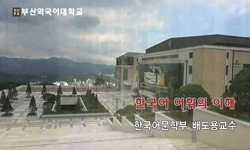This paper aims to examine the diachronic changes of the Middle Korean verb ‘tuwuy-’ in phonology, morphology, and semantics. First, ‘*tuWwuy-’ (“to invert” or “to turn inside out”) was reconstructed based on the reflex of modern south...
http://chineseinput.net/에서 pinyin(병음)방식으로 중국어를 변환할 수 있습니다.
변환된 중국어를 복사하여 사용하시면 됩니다.
- 中文 을 입력하시려면 zhongwen을 입력하시고 space를누르시면됩니다.
- 北京 을 입력하시려면 beijing을 입력하시고 space를 누르시면 됩니다.
https://www.riss.kr/link?id=A104869822
-
저자
이현정 (서울대학교)
- 발행기관
- 학술지명
- 권호사항
-
발행연도
2011
-
작성언어
Korean
-
주제어
‘드위-’ ; 통시적 변화 ; 재구 ; 쌍형어 ; 파생어 ; 의미 분화 ; 방언 분포 ; ‘tuwuy-’ ; diachronic change ; reconstruction ; word pairs ; derived word ; semantic differentiation ; dialect distribution ; ‘tuwuy-’ ; diachronic change ; reconstruction ; word pairs ; derived word ; semantic differentiation ; dialect distribution
-
등재정보
KCI등재
-
자료형태
학술저널
-
수록면
291-310(20쪽)
-
KCI 피인용횟수
0
- 제공처
-
0
상세조회 -
0
다운로드
부가정보
다국어 초록 (Multilingual Abstract)
This paper aims to examine the diachronic changes of the Middle Korean verb ‘tuwuy-’ in phonology, morphology, and semantics. First, ‘*tuWwuy-’ (“to invert” or “to turn inside out”) was reconstructed based on the reflex of modern southeastern and northeastern Korean dialects and the successors of ‘toWoy-’ (“to become”). ‘*tuWwuy-’ was paired up with ‘*toWoy-’(“to invert”) as a word based on the words with prefix ‘twi-’ or ‘toy-’, which make semantic differentiations by vowel opposition, and the verb ‘taypay-’ of northeastern Korean dialects. Second, the formation of the Modern Korean verbs ‘twicip-’ (“to invert”) and ‘twici-’ (“to search through”) were considered. ‘twicip-’ was constituted by combining ‘twuy-’, which changed from ‘tuwuy-’, with ‘cip-’ (“to pick up”), and it was also found that ‘-cip-’ is now in the process of grammaticalization. This is unlike ‘twici-’, which developed from a different origin, ‘twuti-’ which changed from ‘*twut-’ (“to come up to the outside”). Lastly, the current study claims that ‘tuwuy-’ (“to invert” or “to turn inside out”) and ‘tuwuy-’ (“to search through”) were not homonyms, and their meanings were not originally divided because the meaning of ‘tuwuy-’ (“to invert” or “to inside out”) can be transferred to the meaning of ‘tuwuy-’ (“to search through”).
국문 초록 (Abstract)
중세국어의 ‘드위(飜)-’와 ‘드위(搜)-’는 ‘(化)-’의 후계형들과 현대 동남방언과 동북방언의 반사형을 통해 ‘*드-’로 재구할 수 있다. 또한 ‘뒤-’와 ‘되-’가 포함된 구성으...
중세국어의 ‘드위(飜)-’와 ‘드위(搜)-’는 ‘(化)-’의 후계형들과 현대 동남방언과 동북방언의 반사형을 통해 ‘*드-’로 재구할 수 있다. 또한 ‘뒤-’와 ‘되-’가 포함된 구성으로서 모음 교체에 의해 의미 차이를 보이는 어형들과 동북방언의 ‘대배-’를 통해 볼 때 ‘*드-’는 ‘*-’와 쌍형어였을 가능성이 있다. 현대국어의 ‘뒤집-’은 ‘뒤(飜)-’와 ‘집(撮)-’이 결합한 것이며 ‘-집-’은 접사화의 과정에 들어선 것으로 보인다. 이와 달리 현대국어의 ‘뒤지-’는 ‘*둗-’에서 비롯된 ‘두디-’의 후계형으로서 ‘드위(搜)-’와는 그 기원이 다른 것이다. 한편 ‘뒤집-’과 ‘뒤지-’ 및 접두사 ‘뒤-’와 ‘되-’의 의미를 검토해 보면 이들 사이에 의미 전이가 일어날 수 있다는 것을 알 수 있다. 따라서 ‘드위(飜)-’와 ‘드위(搜)-’는 동음이의어가 아니라 기원적으로는 의미가 미분화된 상태였을 가능성이 있다.
참고문헌 (Reference)
1 정원석, "함흥지방방언집" 한국 어린이 문화 연구소 2010
2 김태균, "함북방언사전" 경기대학교출판부 1986
3 곽충구, "함북 육진방언의 음운론" 태학사 1994
4 한국정신문화연구원, "한국방언자료집Ⅰ~Ⅸ" 한국정신문화연구원 1987
5 국립국어연구원, "표준국어대사전" 두산동아 1999
6 김영배, "평안방언연구" 태학사 1997
7 이현희, "중세국어 ‘둗겁-’의 형태론" 63 : 133-150, 1987
8 정승철, "제주도방언의 통시음운론" 태학사 1995
9 이선영, "접두사화에 대한 고찰" 한국어의미학회 13 : 97-116, 2003
10 최명옥, "월성지역어의 음운론" 영남대학교출판부 1982
1 정원석, "함흥지방방언집" 한국 어린이 문화 연구소 2010
2 김태균, "함북방언사전" 경기대학교출판부 1986
3 곽충구, "함북 육진방언의 음운론" 태학사 1994
4 한국정신문화연구원, "한국방언자료집Ⅰ~Ⅸ" 한국정신문화연구원 1987
5 국립국어연구원, "표준국어대사전" 두산동아 1999
6 김영배, "평안방언연구" 태학사 1997
7 이현희, "중세국어 ‘둗겁-’의 형태론" 63 : 133-150, 1987
8 정승철, "제주도방언의 통시음운론" 태학사 1995
9 이선영, "접두사화에 대한 고찰" 한국어의미학회 13 : 97-116, 2003
10 최명옥, "월성지역어의 음운론" 영남대학교출판부 1982
11 허웅, "우리 옛말본-15세기 국어 형태론" 문화사 1975
12 백두현, "영남 문헌어의 음운사 연구" 태학사 1992
13 유창돈, "어휘사연구" 선명문화사 1971
14 이기문, "신정판 국어사개설" 태학사 2005
15 김병제, "방언사전" 과학,백과사전출판사 1980
16 송철의, "국어의 파생어형성 연구" 태학사 1992
17 최명옥, "‘ㅸ, ㅿ’와 동남방언" 14 (14): 185-194, 1978
18 램지, "Accent and morphology in Korean dialects" 국어학회 1978
19 구본관, "15세기 국어 파생법에 대한 연구" 태학사 1998
동일학술지(권/호) 다른 논문
-
‘-느-’의 형태소 분석에 대하여-‘-느-’의 이형태 교체를 중심으로-
- 형태론
- 전후민
- 2011
- KCI등재
-
- 형태론
- 송원용
- 2011
- KCI등재
-
- 형태론
- Kawasaki Keigo
- 2011
- KCI등재
-
- 형태론
- 고영근(高永根)(Ko, Yong-Kun)
- 2011
- KCI등재
분석정보
인용정보 인용지수 설명보기
학술지 이력
| 연월일 | 이력구분 | 이력상세 | 등재구분 |
|---|---|---|---|
| 2026 | 평가예정 | 재인증평가 신청대상 (재인증) | |
| 2020-01-01 | 평가 | 등재학술지 유지 (재인증) |  |
| 2017-01-01 | 평가 | 등재학술지 유지 (계속평가) |  |
| 2013-01-01 | 평가 | 등재학술지 유지 (등재유지) |  |
| 2010-01-01 | 평가 | 등재학술지 유지 (등재유지) |  |
| 2008-01-01 | 평가 | 등재학술지 유지 (등재유지) |  |
| 2005-10-05 | 학술지명변경 | 외국어명 : 미등록 -> Morphology |  |
| 2005-05-30 | 학술지등록 | 한글명 : 형태론외국어명 : 미등록 |  |
| 2005-01-01 | 평가 | 등재학술지 선정 (등재후보2차) |  |
| 2004-01-01 | 평가 | 등재후보 1차 PASS (등재후보1차) |  |
| 2002-07-01 | 평가 | 등재후보학술지 선정 (신규평가) |  |
학술지 인용정보
| 기준연도 | WOS-KCI 통합IF(2년) | KCIF(2년) | KCIF(3년) |
|---|---|---|---|
| 2016 | 1.06 | 1.06 | 1 |
| KCIF(4년) | KCIF(5년) | 중심성지수(3년) | 즉시성지수 |
| 0.94 | 0.87 | 2.426 | 0 |




 KCI
KCI





